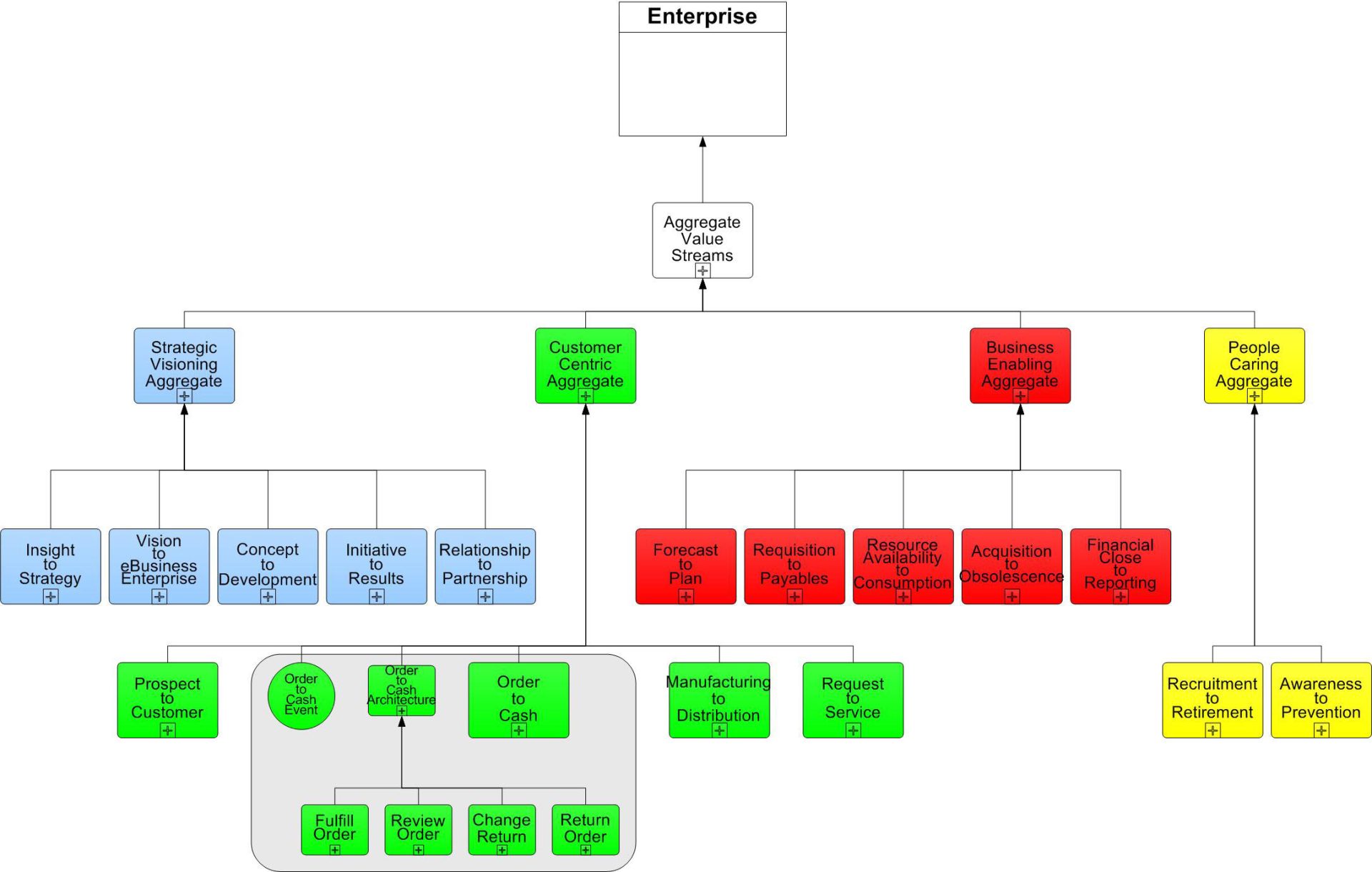How does a Business Architecture (BA) team determine the value streams for their enterprise? Is there a suitable reference available in the public domain of the Web for the team to analyze? Many are familiar with and frequently use the American Productivity and Quality Center (APQC) and its Process Classification Framework (PCF), but does something comparable to the APQC-PCF[1] exist which is organized around value streams by industry? Sadly, the answer is “no.” So what approach should the BA team take and how will they determine the value streams for their enterprise?
In the mid to late 90s, as a member of a consulting team, we found ourselves in this very situation. The client enterprise was developing a new strategic business unit (SBU) for their existing manufacturing company with a very different business model from their other SBUs. Even though we started out with a “functionally centric” focus – Order Entry, Accounts Receivable, Shipping and so on – we soon realized that we needed to expand our thinking beyond the traditional vertical silos and to focus more on the core cross-functional processes or key end-to-end processes. And this approach was strongly advocated by the first C-level executive appointed to this startup SBU. Without question, her encouragement and leadership really made the difference in gaining support throughout the enterprise for this “non-traditional, cross-functional approach.”
At first it was fairly easy since even in the mid to late 90s, numerous books and publications contained many references to core cross-functional processes or key end-to-end processes. For example, many of us were familiar with the terms and meaning of Order to Cash, Procure to Pay and Prospect to Customer. The explosive growth of the Web was still yet to come, but we were making fairly good progress without the Web as a source of information. However, around the time we had identified five or six core cross-functional processes or key end-to-end processes, we seemed to get “stuck.” We had no idea how many core cross-functional processes or key end-to-end processes existed for a typical manufacturer, nor did we know the names and content of the other ones.
Armed with a list of the more noteworthy business and IT authors of the day, I went to the book store in search of a book about core cross-functional processes or key end-to-end processes. And I guess you could say that I got lucky and found one; only one! James Martin, a well-known IT guru and prolific author had written The Great Transition: Using the Seven Disciplines of Enterprise Engineering to Align People, Technology, and Strategy. While thumbing through his book, I found the definition of a value stream on page 104. “A Value Stream is an end-to-end collection of activities that creates a result for a ‘customer,’ who may be the ultimate customer or an internal “end user” of the value stream. The value stream has a clear goal: to satisfy (or, better, to delight) the customer[2].” These days “value streams” are a very well known term, familiar in Six Sigma, Lean Manufacturing and BPM disciplines, but this was back in the 90s. And then on page 107 I found it; “a typical list of value streams for a corporation.” With Martin’s book and his list of value streams, we suddenly became “unstuck” and now had a notable reference to guide us in value stream discovery and development. How fortuitous!
However, it was not as easy as simply copying the list of value streams from Martin’s book. We spent quite a bit of time studying the book, especially Part II Value Stream Reinvention, Chapters 7 through 13. Funny thing happened though, as we began to look at the new SBU from the perspective of the customer, we began to see it and its operations very differently. Expanding up from the traditional functionally centric view to a customer centric view created many lively and colorful discussions. And making the transition from internal functional silos to cross-functional end-to-end customer centric views was sometimes difficult but quite insightful. And something else happened too; from the value stream perspective, we began to see the new strategic business unit as totally connected. That is, not only did we see the “end-to-end” view from the customer perspective, but we began to see how one value stream was connected to or influenced by or related to another value stream. We began to view the new SBU from an holistic perspective. As our understanding of the whole strategic business unit grew, so did our maturity with value stream thinking. And then we began to restructure the first draft of our value streams. In fact we began to refer to our value streams as “candidates” and we set expectations that we were going to enhance and improve the value stream structure as we continued to develop our value stream expertise. We finally concluded with a value stream model similar to Figure 1 representing a generic build-to-order manufacturer.

Figure 1 – Value Streams for a Generic Build-to-Order Manufacturer
We also considered the reuse of value streams from the enterprise perspective. Even though the value streams in the enterprise’s other strategic business units were not identified nor understood, we were able to create a practical draft of them for reuse in our engagement. For example, the Insight to Strategy and Recruitment to Retirement value streams from the enterprise were shared by all SBUs and did not require any new development by our engagement team. Others such as Prospect to Customer and Order to Cash were significantly different as required by the new strategic business unit’s unique business model and were designed from the ground up. Had we decided to stay put in a functional paradigm, I am not sure how we would have reconciled the reuse and uniqueness of functions across strategic business units so quickly, much less acquired a customer centric perspective. But I can tell you, by using Martins’ book and his sage approach, we discovered the “candidate” value streams, both ones shared with the rest of the corporation and new ones rather quickly.
I encourage the reader to carefully review the models in Figure 1 by clicking on the various value streams represented by the colored horizontal rectangles on the web site. Please use Internet Explorer as the navigation and hyperlinks are configured for this browser; other browsers do not support the navigation and hyperlinks. The integration and linkages between the value streams illustrated though their inputs/outputs enables the reader to understand how each is connected to or influenced by or related to another value stream; a view obscured by the functionally centric view.
Even with all of the lively and colorful discussions, the most exciting thing about discovering the value streams was the fact that we got to participate in the design of a new strategic business unit using the value stream approach. Think about it; how often does a team or individual get to design a new SBU or redesign an existing enterprise/SBU using the value stream approach. It was the most true and honest execution of the role of a Business Architect that we had ever experienced. Looking back, it was also the most fun and challenging opportunity of our careers.
References:
- American Productivity and Quality Center (APQC) Home Page.
- James Martin, The Great Transition: Using the Seven Disciplines of Enterprise Engineering to Align People, Technology, and Strategy (American Management Association 1995), 104.

















